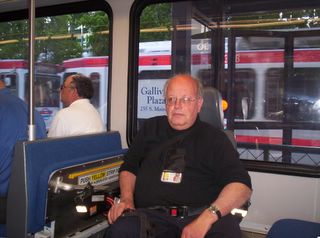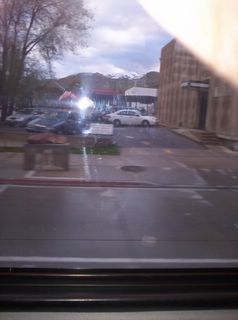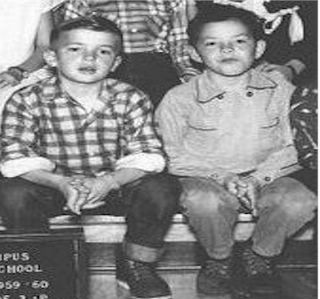
driver's cab
I thought I have spoke about the process of people with disabilities accessing the train. But, I have just searched most of the blog and there is no account that I can find which describes this process. So, here it goes. A person with a mobile disability can only access the Trax car from what is called a mini-high block: a concrete , switch back ramp that elevate the wheelchair user, crutch user or person who uses a cane, dog or some device to board the train. Even folks who cannot climb the huge three steps to the train may use the mini-high block to get onto the train.
The first car of the train is the only car people with disabilities can access. This fact drives me crazy—but that is fodder for another blog. This is because the drive of the trainer, the “operator” must physically unlock his door and leave the his little cockpit and open the doors of the train and actually lower a broad metal plate called the “bridge”. The “bridge” crosses the space between the train and the concrete bock making a bridge that a person using a wheelchair or whatever can use to roll across and enter the car. You assume things when certain things are all you are ever exposed to. Since I have to ride in the first car I thought everyone had a front car mentality. They don’t. Most people who ride the system, I’ll wager, never think of the operator. They must notice him as the train comes into the station but I bet they do not even notice then. People with disabilities tend to be come very much aware of the drivers—for they are the “gate keepers”, the operators are often your first contact with the Authority and your transit system. The driver smiles at you, when you board or growls at you or does not even acknowledge you. You, as a person can often sense the driver’s mood my the way he lets you on to the train. It really is a process a time consuming process. The first two seats of the first car are really jump seats which are folded up when a person using a wheelchair is on board making a nice little compartment for that person. Able bodied folks must relinquish these seats to folks with disabilities when the disabled folks enter.
Each operator, whether the operator drives a bus or a train wears a number and his name on his right shoulder. As a consumer entering the vehicle you should note the identification pieces. If the driver then does something offensive, dangerous questionable or something really, really, good you can let the folks at Management know, who will, hopefully take appropriate actions. Last Bo was the operator of my train. Now Bo is an OK guy—sort of—in a perfect world he would operate the train and I am sure he would operate the train well. If it’s just he and his train Bo does just fine, however add the human variable and Bo begins to disintegrate. Not that Bo’s evil, I think he has some evil characteristics. I can easily picture Bo, covered in sheets riding a horse caring a burning cross. Bo’s a balding, endomorphic, suspender wearing, 50 year old white man, with an unnaturally high pitched voice who wishes the world would leave him alone and let him drive his train. When I started regularly riding the he was my steady night operator. Bo is a “light talker” so soft is his voice that with the din of the world when entering the train you might not here him say anything. The operators ask you when you board what station you wish to be left off at. This really threatened me at first but the more I thought about it the more sense it made to let the driver know where you want to de-board. Nuff said, Bo and I have gone the rounds enough so I eventually took his number and reported him to management. He was pulled and retrained. I was not the only rider who had dealt with Bo. We tolerate each other now. I have not ad Bo for a driver for month now. I did not even know he was till driving—but there was Bo, climbing into the training and bring the drain up to the mini-high block where I was sitting. We kind a acknowledged each other. I volunteered by deboarding station and settled back into my place. Opsite me there was sitting women who looked very much like she did not wsh to be bothered. I could immediately sense the tension between Bo and the other folks in the car. I just wished Bo would lock himself back into his cab and drive. Every thing went well till be got to the Galvin Station—Bo opened the cab door with a flourish and ordered the women in the seat opposite me to remove her self from the seat indicating there were picking up a person with a disability.
Bo next, opened the door and walked out onto the platform and leaned over the rail as if to be waiting for someone
Cross woman:
He can’t make me do that. I know the rules and he can only make me leave if a disabled person is coming aboard. I don’t see one either. That’s a stupid law anyway.
I just focused on reading my book. The driver is standing on the mini looking like a U-boat captain, searching for prey. I mean Bo must have been standing there for three or four minutes which is eons in train time especially with another train up your butt in ten or fifteen minutes. The time was about 5:30 still with in the home “rush hour”…the trains will run ten minute headways. Bo finally turned and came back into the train and muttered I guess they are not coming and lowered the jump seat turned entered and locked himself back into the cab and started the train forward. This really started Cross Lady yammering after she in fact she yammered all the way to the next stop where Barbara a post polio friend of mine, and who uses a power wheelchair for mobility entered the train. This time with a glint in his eye Bo made Cross woman vacate the seat again, and he flipped the seat up and Barbara came aboard and sat close to me in the aisle, not using the prescribed seating—Cross Woman is now turning red muttering seeming ready to explode. I hold my breath focus on Barb and travel down the track. Barb is off in two stops and I and off at the next. I feel the stress leave me as I exit the train. I wished Bo a good night as I left the train but I could not tell if Bo said good bye















